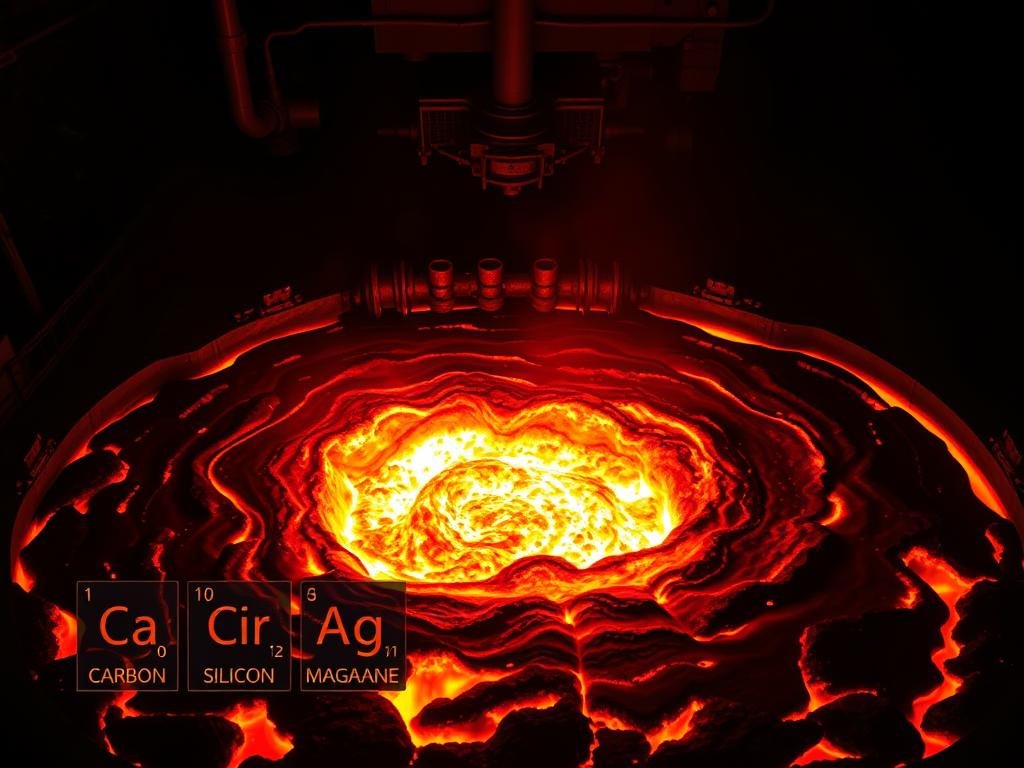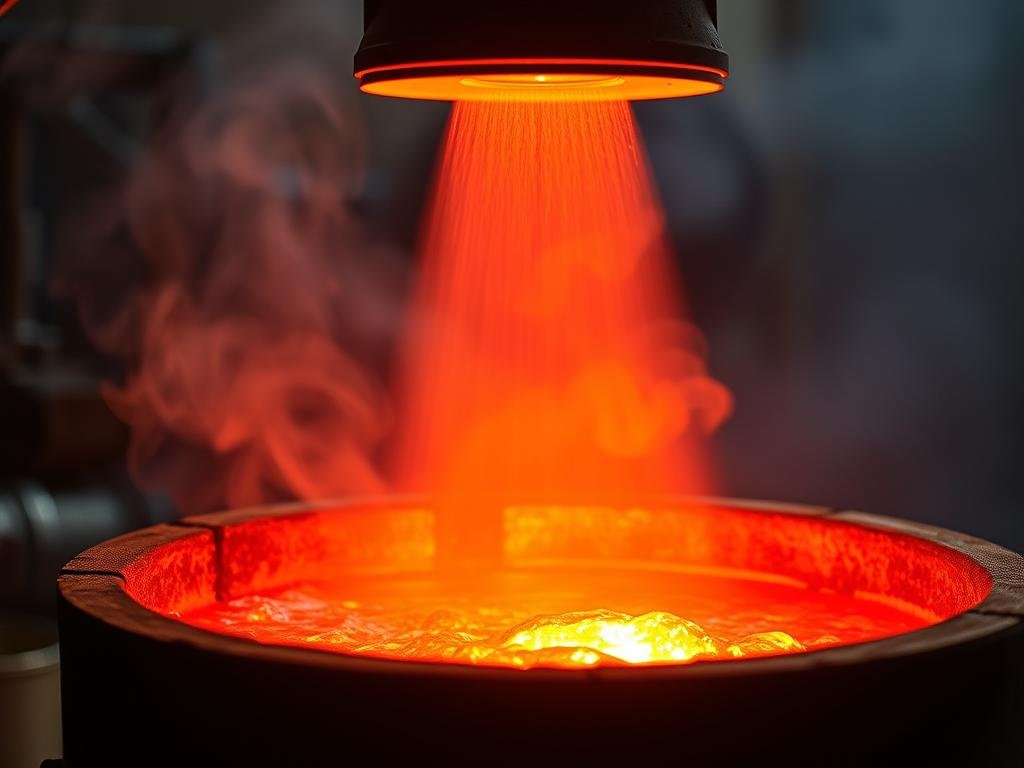The melting point of iron, approximately 1,538°C (2,800°F), is a critical parameter in metallurgy and manufacturing. This fundamental property influences the behavior and applications of iron in various industries, from construction to automotive.
At such a high temperature, iron’s strong atomic bonds require significant energy to break, making it a vital component in the production of steel and other alloys. Understanding the melting characteristics of iron is essential for engineers and metallurgists working with iron-based materials.
This article will explore the science behind iron’s melting behavior, factors that affect it, and its significance in various industrial applications.
Understanding Iron’s Melting Point
Understanding the melting point of iron is essential for metallurgists and manufacturers alike. The melting point is a critical property that determines the usability of iron in various industrial applications.
What Is the Melting Point of Pure Iron?
Pure iron has a melting point of 1,538°C (2,800°F). This is a well-defined physical property that serves as a reference point for understanding the melting behavior of different iron alloys.
Melting Points of Different Types of Iron
Different types of iron exhibit varying melting points due to differences in their composition. For instance, cast iron melts at a significantly lower temperature range of 1,150-1,200°C (2,102-2,192°F) compared to pure iron. Wrought iron, with its minimal carbon content, has a melting range of 1,482-1,593°C (2,700-2,900°F).
As noted by experts, “The presence of carbon and other alloying elements significantly affects the melting point of iron alloys.” Various types of cast iron, including gray, white, and ductile iron, have distinct melting ranges based on their specific composition and microstructure.
- Cast iron’s lower melting point makes it suitable for casting applications.
- Carbon steel, an alloy of iron, melts between 1,425-1,540°C (2,597-2,804°F), demonstrating the impact of carbon content on melting temperature.
Factors Affecting Iron’s Melting Point
The melting behavior of iron is impacted by several important considerations, including its purity, the presence of impurities, and the pressure conditions under which it is melted.
Purity and Composition
The purity and composition of iron significantly affect its melting point. Pure iron has a specific melting point, but variations in composition can alter this temperature.
Presence of Impurities
Impurities within iron can lower its melting point by introducing elements that have different melting behaviors, thus affecting the overall melting characteristics of the material.
Pressure Conditions
Pressure conditions also play a crucial role in determining iron’s melting point. At higher pressures, the melting point increases due to the need for more energy to overcome the increased atomic interactions.
| Factor | Effect on Melting Point | Relevance |
|---|---|---|
| Purity | Significant impact | High |
| Impurities | Lowers melting point | High |
| Pressure | Increases melting point | Moderate |

Iron Melting Point in Manufacturing Processes
Understanding iron’s melting point is essential for optimizing manufacturing processes. The melting point influences various industrial applications, including casting, welding, forging, and heat treatment.
Casting Applications
In casting, iron is heated beyond its melting point to achieve a liquid state, allowing it to be poured into molds. The precise control of temperature is crucial to prevent defects and ensure the quality of the castings.
Welding Considerations
Welding involves joining iron parts by heating them to a high temperature, often approaching but not necessarily exceeding the melting point. The thermal management during welding is critical to prevent warping or weakening of the material.
Forging and Heat Treatment
Forging and heat treatment processes rely on heating iron to specific temperatures below its melting point. For instance, forging operations typically heat iron to between 900°C and 1,200°C, making it malleable. Heat treatment processes like annealing, quenching, and tempering also depend on precise temperature control relative to iron’s melting point.
| Process | Temperature Range (°C) | Purpose |
|---|---|---|
| Forging | 900 – 1,200 | Shaping iron |
| Annealing | Approaching melting point | Relieve internal stresses |
| Quenching | Near 900 | Create specific microstructures |
| Tempering | 150 – 650 | Balance hardness and toughness |
Methods for Melting Iron
To melt iron, various methods are employed, each with its advantages and specific applications. The choice of method depends on factors such as the type of iron, the desired purity of the molten metal, and the specific requirements of the manufacturing process.
Blast Furnace Technology
Blast furnaces are a traditional method for melt iron, using a mixture of iron ore, coke, and limestone. This process is energy-intensive but can produce large quantities of molten iron.
Electric Arc Furnaces
Electric arc furnaces (EAFs) are widely used for melting metal, including iron. EAFs use an electric arc to heat the metal, offering a more energy-efficient alternative to blast furnaces for certain applications.
Induction Furnaces
An induction furnace employs electromagnetic induction to heat iron in a crucible efficiently. Key benefits include:
- Precise temperature control relative to iron’s melting point, ideal for specialty alloys.
- Non-contact heating minimizes contamination, producing higher purity metal.
- Rapid heating reduces energy consumption and oxidation losses.
- Gentle stirring action through electromagnetic forces creates homogeneous molten iron.
| Melting Method | Energy Efficiency | Purity Control |
|---|---|---|
| Blast Furnace | Low | Moderate |
| Electric Arc Furnace | Moderate | High |
| Induction Furnace | High | Very High |
Comparing Iron’s Melting Point to Other Metals
The melting point of iron relative to other metals plays a vital role in metallurgy and material science. This comparison is essential for understanding the suitability of iron for various applications.
Common Industrial Metals
Industrial metals like nickel have melting points that are comparable or different from iron. For instance, nickel melts at 1,455°C, which is relatively close to iron’s melting point, making their alloys useful in certain applications.
Precious and Specialty Metals
Precious metals such as gold (1,064°C) and silver (961.8°C) have significantly lower melting points than iron. In contrast, specialty metals like tungsten (3,422°C) and molybdenum (2,623°C) have much higher melting points, making them ideal for high-temperature applications. As noted by a metallurgy expert, “The choice of metal often depends on its melting point and how it interacts with other elements.”
“The properties of metals, including their melting points, are crucial in determining their uses in various industries.”
This highlights the importance of comparing melting points to select the right metal for specific uses.
The Role of Carbon in Iron’s Melting Point
The presence of carbon in iron significantly influences its melting point, a crucial factor in metallurgical processes. This effect is particularly important in the production of steel and cast iron, where carbon content varies widely.
How Carbon Lowers Melting Temperature
Carbon lowers the melting temperature of iron by forming iron-carbon alloys. As carbon content increases, the melting point decreases. For instance, pure iron melts at 1,538°C, while cast irons with 2-4% carbon melt between 1,150-1,200°C.

Steel vs. Pure Iron Melting Points
Steel, an alloy of iron and carbon, has a melting point that varies with carbon content. Low-carbon steels melt around 1,500°C, while high-carbon steels melt between 1,380-1,430°C. This range is significantly lower than pure iron’s melting point, demonstrating carbon’s substantial influence on iron’s thermal behavior.
Conclusion: The Significance of Iron’s Melting Point in Modern Industry
As a fundamental property, iron’s melting point has far-reaching implications for its utilization in contemporary industry.
The melting point of iron, approximately 1,538°C (2,800°F), is a critical aspect of metal processing that influences various manufacturing techniques. From casting and forging to welding and heat treatment, knowing this critical property ensures that processes are executed efficiently and with high quality.
Proper management of the melting point enables the production of reliable and durable iron-based components, essential in many industrial applications. Modern manufacturing processes leverage sophisticated temperature control systems calibrated around iron’s melting characteristics to ensure consistent quality and performance in iron-based products.
The relationship between iron’s melting point and its crystalline structure continues to be an area of research that promises new insights into this ancient yet still critically important material. As industry continues to evolve, the fundamental knowledge of iron’s melting behavior remains essential for developing new materials and processes.
